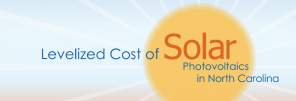
NCSEA Study Finds Decline in Solar Costs
A new report, completed by the North Carolina Sustainable Energy Association, found that, “conventional electricity costs have increased by an annual average of approximately 3 percent over the past decade.” The study then reported, “the national trend for the cost of solar photovoltaics (PV) panels and their subcomponents has declined by 37 percent from 2008 to 2010.”
Key Findings from the “Levelized Cost of Solar Photovoltaics in North Carolina”
– For many electric utilities, solar PV systems greater than 10 kW with federal and state tax credits were at grid parity (cost competitive with commercial retail electricity prices) in North Carolina in 2011.
– For all North Carolina electric utilities, solar PV systems greater than 500 kW with federal and state tax credits achieve grid parity or become cost competitive with commercial retail electricity prices in 2015.
– For all North Carolina electric utilities, solar PV systems greater than 10 kW through 500 kW with federal and state tax credits achieve grid parity or become cost competitive with commercial retail electricity prices in 2018.
– For the majority of North Carolina electric utilities, solar PV systems 10 kW or less taking federal and state tax credits achieve grid parity or become cost competitive with residential retail electricity prices in 2020.
– For many electric utilities, solar PV without federal and state tax credits will be at grid parity or cost competitive with retail electricity prices in North Carolina in 2020.
Although this is wonderful news for the solar industry, Green State Power has been aware of the competitive solar pricing for a long time now. While the average installed cost per watt (W) of solar PV in North Carolina has decreased to $5.44/W, according to the NCSEA report, Green State Power has been able to offer solar PV installations for nearly 60% less! Contact Green State Power for a quote or a site visit soon to see how inexpensive solar can really be.
The entire 35-page report can be downloaded here (PDF).
